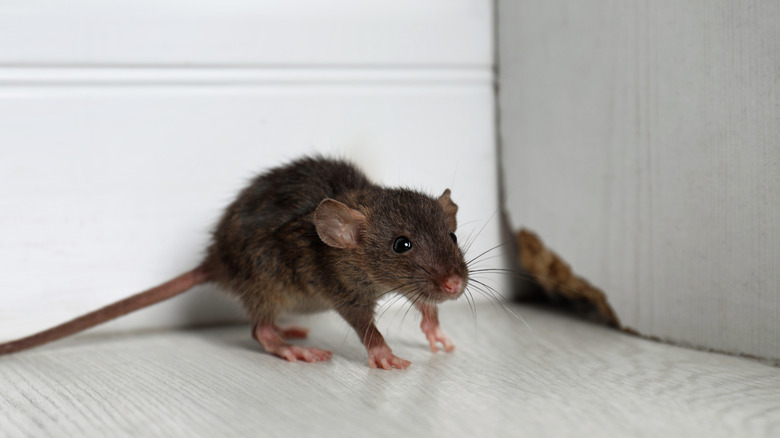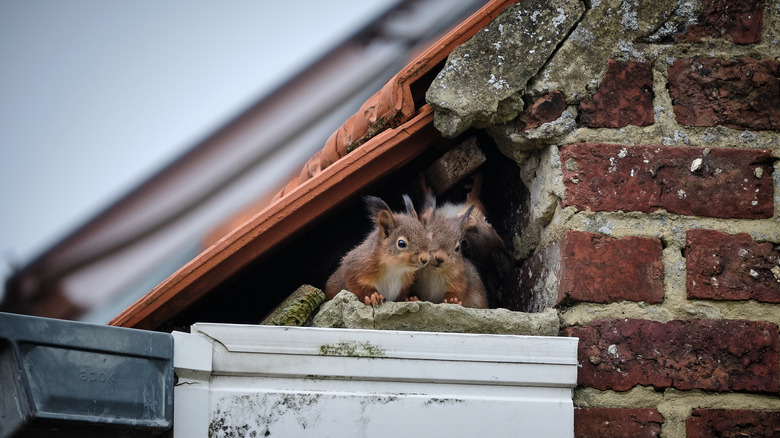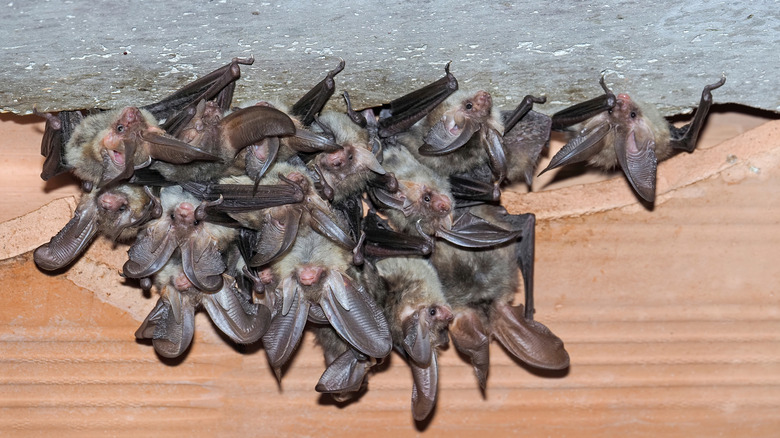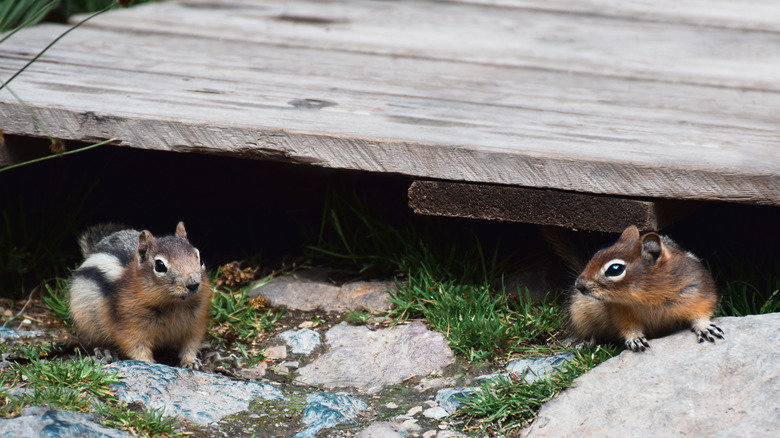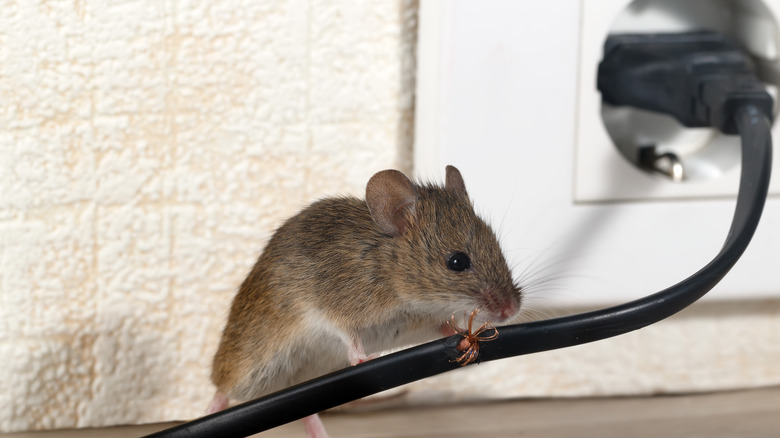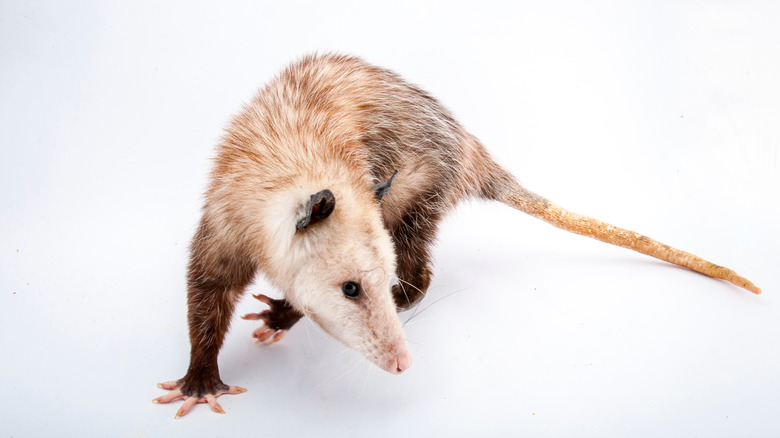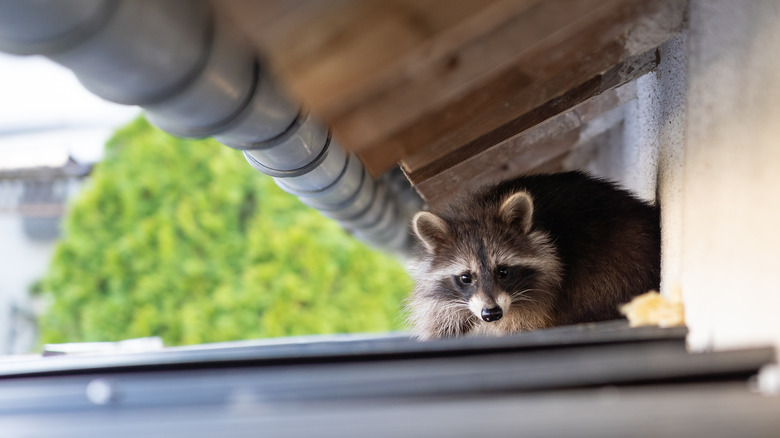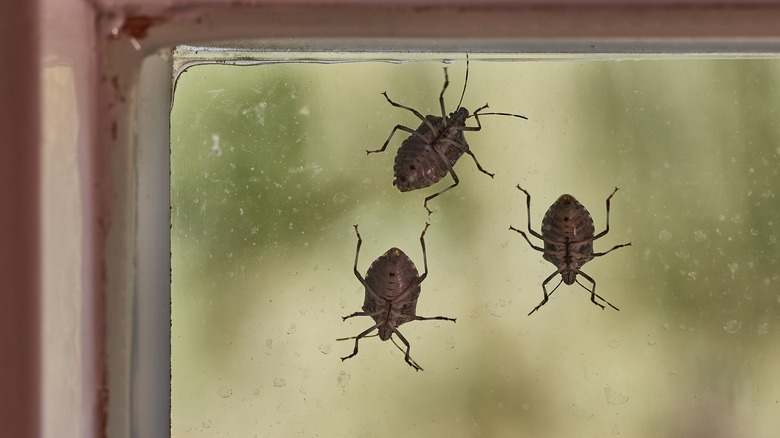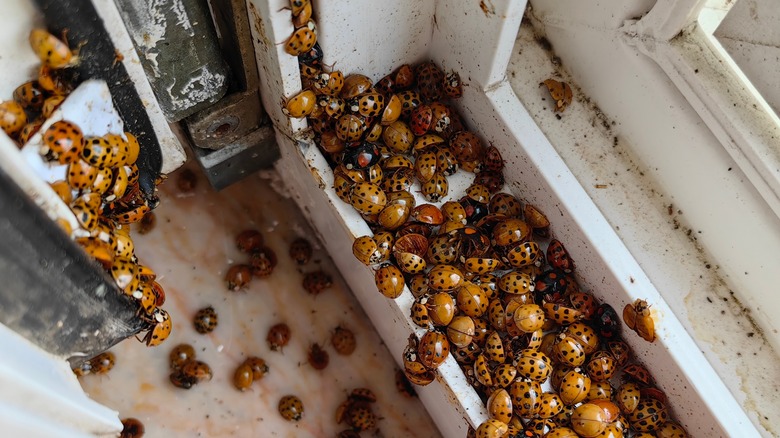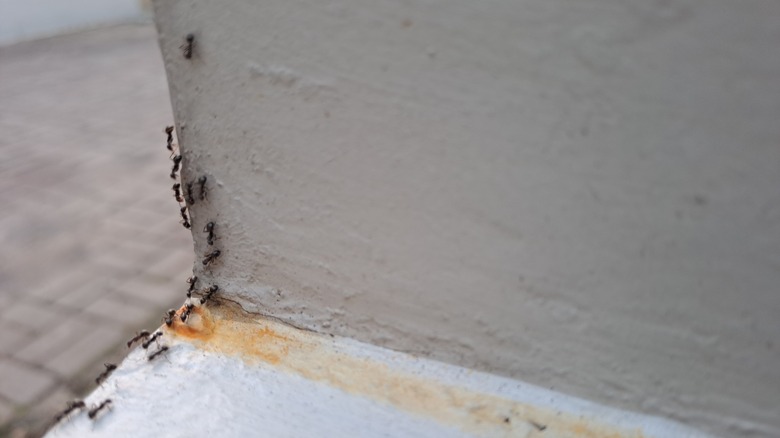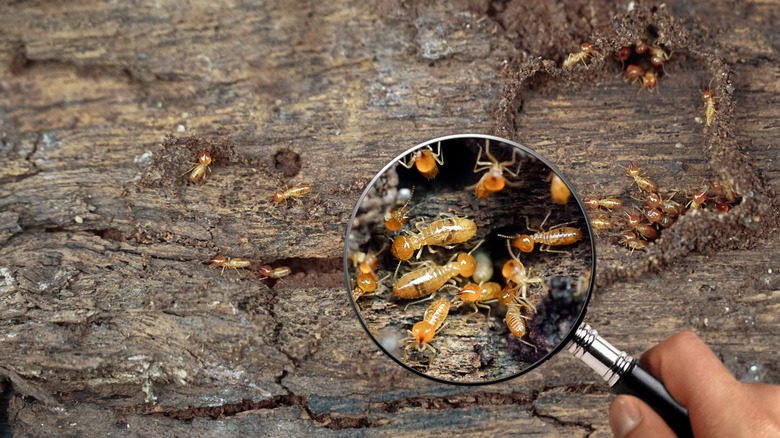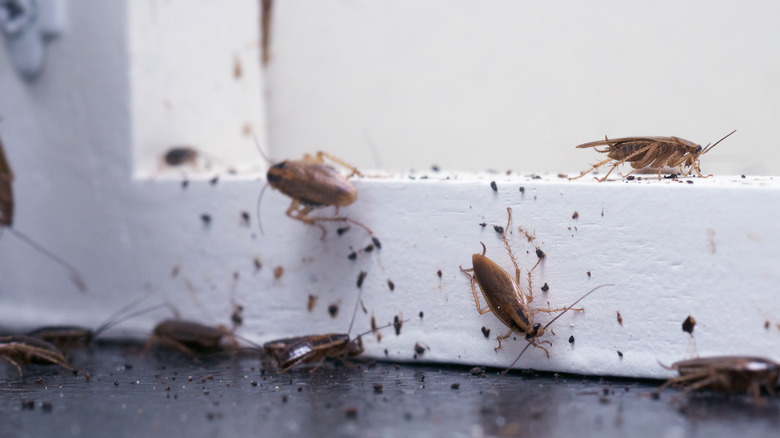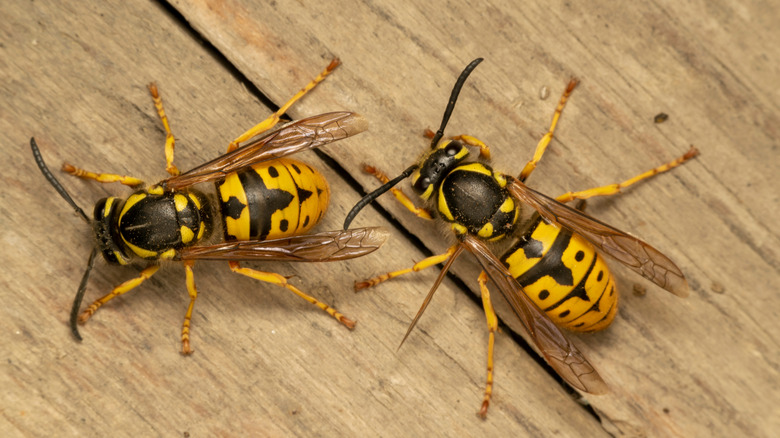Pests You Don't Want To Find Hiding In The Walls Of Your Home
If walls could talk, what stories would they tell you about the pests lurking in them? Fortunately, there are many ways to tell if your walls are full of unwanted pests. The scratching, chirping, and scurrying feet are a dead giveaway that you have a pest infestation. And then there are the droppings, foul odors, and occasional sightings of intruders that are living rent-free inside your walls. Some home invaders are just passing through and are only here for the winter. Others, however, will build nests, chew at the wirings, wood, and plaster, and reclaim more territory for their growing community.
It doesn't matter what type of walls you have — insects and rodents will find a way inside partition walls, drywalls, or stone walls. A small crack in the corner is all that an enterprising mouse or ladybug needs to access the cavities inside the wall. Having such unwelcome visitors living with you can lead to serious health risks for your household and damage to your property. To stay one step ahead of the pests, you need to identify them, kick them out of the wall, and take precautions to prevent any future infestations.
Squirrels
Squirrels are agile and hyperactive critters with many natural enemies. They seek shelter inside a cavity in the wall where it's warm and safe to build a home, store their food for the winter, and raise a few baby squirrels. In other words, they're in for the long haul. The first sign that you have the little animals in your home is the scratching and scurrying noise they make. You might also notice claw marks, as well as chewing on the wall and around the vents in the house. If you miss all of that, you can't miss the droppings on the floor, the damp urine patches on the wall, and the foul odor of the stains. Inside the wall, squirrels gnaw on the insulation and electrical wires, creating a fire risk.
The best way to deal with squirrels in the wall is to trap them. Squirrel traps are an effective way to lure the animals out of their hiding place. Placing some peanut butter or nuts inside the trap, set it up near the opening of their nest. If you have more than one squirrel, you'll need to set the trap a few times. When you've got them all out of the wall, seal the hole with caulk or plywood, and do the same for any vents or openings in the house that give them access inside your home.
Bats
Although bats generally prefer attics, they will settle inside a wall cavity when they find one. Bats are nocturnal, and signs of infestations are more noticeable at night. Sharp squeaking sounds that stop if you make a noise near the wall are a good clue you have a bat problem. The other sign is when you see bats flying in and out of the house. The animals sleep hanging upside down inside the wall during the day. Once a bat moves in, they attract other bats, which damages the insulation with guano pile up. There's also a health risk for the household with having a lot of bat droppings inside the wall.
Bats hate the smell of ammonia, chili powder, citrus fruits, and mothballs, among other scents. If you have just a few bats in the wall, using these repellents could get rid of them. Another approach is to use devices that emit high pitch sounds. Since the animals rely on their ears to navigate, the devices would disorient them and force them to leave. You could also use a flashlight inside the hole to chase the sleeping bats out of the wall. If you have a large bat infestation, consider calling a professional.
Chipmunks
Tiny and fast, chipmunks are a serious challenge once they make a home inside your walls. They're easy to identify with their chirping noises and chew marks around the nest opening. The striped animals have strong front teeth that grow all the time, similar to human fingernails. To keep those teeth in check, chipmunks gnaw on everything around them. When they settle inside the cavity, they gnaw on wood, plastic, wall insulation, and wires. The damage to the walls can be costly. Moreover, the rodents are often infested with parasites, ticks, fleas, and mites hiding in their fur. These bugs could create another pest problem of their own and cause diseases to the people and pets in the house.
The safest and most humane way to get rid of chipmunks is to trap and remove them. Avoid using traps in the spring when the rodents have babies. Sealing babies in a wall isn't just inhumane, but the mother will destroy the wall to free them. To prevent chipmunks from getting back into your house, seal all cracks in the outside walls and roof. The animals can sneak through an open window, so using screens is a good way to keep them out.
Mice and rats
Both mice and rats are adept at hiding in walls for a long time before you even notice them. They choose the inside of a wall merely out of convenience, but they're mainly attracted to the food in the kitchen and pantry. Once they've settled in, the rodents start chewing everything in sight. They gnaw at the kitchen cabinets, food containers, ducts, and wooden furniture. To build their nests inside the wall, they'll also chew holes in fabrics and cardboard boxes. Other signs of having a mouse or a rat in the house include a pile of droppings in a corner, foul odors, and squeaking sounds coming from inside the wall at night.
Whether it's a rat or a mouse that's living inside your wall, you need to get rid of it fast. A live trap is the most effective way to get rid of mice in your walls. The trap will not kill the rodent and you can release it later without harm. Next, you need to prevent future mouse and rat visits. Going around the house, look for any openings, cracks, or gaps between the windows and doors and the wall. Use caulk to seal those openings as well as the rodent's nest in the wall.
Opossums
If opossums live in your area, there's a good chance they might end up living in your walls. The animals don't just seek comfort in a cavity in the wall, but they also need a safe place to breed and raise a litter of opossums. You can't mistake the squeaking and scraping the animals make inside the wall all day long. But that's not the only problem with hosting a family of opossums — or even a single one — in your house. The animals carry and transmit a number of diseases including tuberculosis, rabies, spotted fever, relapsing fever, and Chagas disease. Their fur hides pests such as ticks and fleas which can jump to pets and children in your house. Moreover, opossums are avid chewers and they can cause a lot of damage to the walls and furniture in your home.
To get rid of opossums in the wall, wait for the animal to leave the nest, then seal the opening with caulk. Spreading opossum repellents such as ammonia and mothballs around the house may keep the animals from coming back. But if there are opossum babies in the nest, the only way to get to them is to cut through the wall. You'll need to call a wildlife removal professional to remove the animals.
Raccoons
Raccoons usually prefer to raid garbage cans and break into attics and garages. But if a wall has a wide enough cavity, they might nest in it. This gives them access to the inside of the house and your food supply. However, to get into and out of the wall, the raccoon will make a lot of noise that includes shuffling, scratching, crawling, and dragging. Most of the noise will happen during the night when the animal becomes active. It's not safe to have a raccoon around since they carry diseases such as rabies, infectious canine hepatitis, and canine distemper. They also cause a lot of damage to the walls they live in.
These animals can be quite aggressive, so you need to wear protective gear such as gloves and goggles before trying to remove them. Setting a live trap will help you snare the animal, which you can then release far from your home. Before you seal the hole in the wall, check if there are baby raccoons in the nest. To gain access to the trapped babies, cut a section in the wall near their nest. It's recommended to release both the mother and babies in the same spot to allow the mother to take care of them.
Stink bugs
Stink bugs are a good example of a pest that seeks a cool and dry place to spend the winter in. The inside of your walls provides a perfect overwintering place for the bugs. There's only one species, the brown marmorated stink bug, that invades homes and hides until the spring. The bug is less than an inch long and wide and produces a stinky odor when it feels threatened. Native to East Asia, the bug has spread across the U.S. and seeks shelter inside homes in the fall. Stink bugs don't bite, transmit diseases, or cause damage to the property. But their presence inside the walls is more of a nuisance.
To remove stink bugs from inside your walls, you need to locate them first. Once you have found the crack in the wall that gave them access to the cavity inside, use the vacuum to suck them out of the wall. Keep in mind that the panicking bugs might stink in the vacuum. After removing the pests, seal all cracks in the walls and around electrical outlets and switch boxes and install screens on vents. You could also spray the outside walls with a pesticide in the fall to prevent the bugs from entering your home to overwinter.
Ladybugs
Ladybugs are a gardener's best friend. But when they enter your home, they become a nightmare. Out of the 5,000 ladybug species, the Asian lady beetle is the most aggressive and the one you will find hiding inside your walls in the winter. The bug has black spots covering an oval shell that varies in color between orange, red, and yellow. Inside homes, Asian lady beetles don't look for food, damage the walls, or even reproduce while hibernating. However, their presence poses a serious health risk for the household. When handled, they produce a yellow pungent chemical that stains surfaces. Moreover, the chemical irritates the eyes and can trigger allergies in asthmatic people.
A vacuum is all you need to get rid of the bugs hiding in crevices in the wall. To prevent these infestations, you need to keep them from entering your house. Ladybugs move into homes in the fall when the weather cools down. That's the time to install screens on windows, seal or caulk openings and cracks in the walls, and keep doors shut during the day. The tiny bugs can crawl under your doors, so fitting them with door sweeps or installing thresholds should keep them out.
Carpenter ants
Known for their love of carving tunnels and galleries in wood, carpenter ants are a formidable foe to watch out for. They can gain access to the inside of the wall through a small crack and settle in. In building a nest, they will cause a lot of damage to the walls, insulation sheets, and wooden structures. The ants are attracted to damp and warm wooden walls and ceilings that are easy to burrow into, and their damage can remain undetected for a long time. The ants are a quarter to three-quarter inch long and are black or reddish-brown. Signs of infestation include piles of wood dust, ragged holes in wooden structures, and the remains of dead ants lying around.
The sooner you remove the destructive ants from your home, the better it is for the integrity of the house and your peace of mind. One of the easiest ways to get rid of carpenter ants is to drill holes in the wall and inject liquid insecticide into the nest. Alternatively, you could sprinkle diatomaceous earth or place ant bait near the colony. Eliminating sources of dampness and moisture, such as leaky faucets, is a good way to keep wooden structures dry and inhospitable to carpenter ants.
Termites
Termites are tiny bugs that live inside wooden walls and cause extensive damage. Unlike other pests that simply use the wall cavity as a nest, termites feed on the wood, literally eating the walls from the inside. The first sign of a termite infestation is tiny holes in the walls where the bugs have gained access. Tapping on the wall gives back a hollow sound. And if you look closely, you can see the tunnels they have burrowed through drywalls and piles of wood dust on the floor. Termites also attract carpenter ants who feed on the bugs.
Termites are dangerous insects that can undermine the integrity of the house. Before you apply any treatment, you need to locate the areas in the wall where they are most active. One way to eliminate the insects is to apply a termiticide on the infected wall. You can also inject boric acid directly where the termites are feeding. Boric acid is lethal to the bugs and once they consume it, they will die. Always follow safety precautions when handling the acid since it is toxic and causes skin irritation.
Roaches
There's a reason roaches are despised so much. They're sneaky and adaptable, which makes them hard to get rid of. Roaches will readily occupy a cavity in the wall if they can get through the opening. Once there, the pests will follow the electrical wires and pipes in the wall to navigate around the house without being seen. A few roaches in the wall are hard to detect, but when you have a large infestation, you'll notice a foul odor coming off the wall. You might also see their droppings as tiny dark specks on the floor near cracks and openings. It's not uncommon to notice the shed skin of the pests in odd places around the house. The pests carry pathogens that cause E. coli, sepsis, typhoid, and salmonella, among others.
One way to get rid of roaches is to use sticky traps near the cracks where you have seen their droppings. When the roach walks on the adhesive surface, it gets stuck and can't escape. If you have a large infestation, you should give a professional exterminator a call. To prevent future infestations, always clean your kitchen at the end of the day, store away all food sources, and eliminate moisture.
Yellowjackets
Yellowjackets are venomous wasps known for their aggression. When these pests find a cavity in the wall, they'll build a nest and chew into the drywall or caulk to expand the cavity. The first sign that you might have a yellowjacket infestation is the number of wasps flying in and out of your house during the daytime. The territorial pests might sting humans and pets in the house since they perceive them as a threat. Unlike a bee, yellowjackets can sting more than once and often attack in groups. The stings can cause allergic reactions with symptoms such as coughing, sweating, and difficulty breathing.
When yellowjackets are nesting in your walls, don't try to get rid of them without a professional. Usually, the exterminator will suck the wasps out of the wall with a vacuum trap. Another option is to cut a section in the wall to remove the nest. After the wasps have been eliminated, cover the outside garbage cans that attract them.
